Archivo de noticias y eventos
1301 - 1350 de un total de 2402
También puede acceder a la lista de noticias publicadas en los medios relacionadas con el Instituto de Astrofísica de Andalucía - CSIC.
Pages

|
05/12/2013 - 13:30
Stellar water fountains: planetary nebulae in the making Planetary nebulae (PN) are one of the final phases in the evolution of low and intermediate mass stars (<8 Msun). They display a great variety of shapes, although in their previous phases (Asymptotic giant branch =AGB) they have a spherical geometry. The transition from spherical symmetry to asymmetry must occur during the short post-AGB phase or in the early PN phase. Here we present a special type of evolved stars, called "... Dr. JFrancisco Gómez |

|
28/11/2013 - 13:30
Galaxy clusters: galaxy laboratories and cosmological probes. A see you later seminar. In this talk -my last one in the IAA for the moment- I will talk about the largest structures in the Universe: galaxy clusters. The first part of the talk will be focused on galaxy clusters embedded in the large scale structure: how we detect them and how we can use them to provide estimations of cosmological parameters. In the second part, I will talk about the galaxies living in clusters, in particular, about the brightest cluster... Dr. Begoña Ascaso |

|
27/11/2013 - 10:30
Deconvolución de datos fotométricos SHARDS y IRAC: aplicación al estudio de LAEs a z>5 Los estudios fotométricos en óptico en IR de fuentes débiles son una perfecta alternativa a la espectroscopía, ya que ésta última técnica es ineficiente para este tipo de fuentes. Sin embargo, las imágenes fotométricas pueden poseer bajas resoluciones, tanto espacial como angular. La baja resolución angular puede deberse o bien al seeing atmosférico, en el caso de... naím Ramírez Olivencia Sala de Juntas del Nuevo Edificio (IAA-CSIC) |

|
19/11/2013 - 22/11/2013
The Galactic Center Black Hole Laboratory Granada |
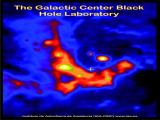
|
18/11/2013
El agujero negro del centro de la Vía Láctea como laboratorio de estudio Esta semana se dan cita en el Instituto de Astrofísica de Andalucía (IAA-CSIC) expertos de todo el mundo para debatir los avances en el estudio del centro galáctico |
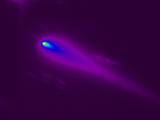
|
14/11/2013
El cometa ISON sufre un estallido de actividad y ya es observable a simple vista Investigadores del Instituto de Astrofísica de Andalucía (IAA-CSIC) informan de un súbito aumento en el brillo y la producción de gases del cometa ISON |
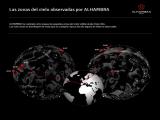
|
13/11/2013
Diez mil millones de años de evolución cósmica al alcance de la mano Desarrollado desde el Observatorio de Calar Alto, ALHAMBRA ha identificado, clasificado y calculado la distancia de más de medio millón de galaxias repartidas en ocho regiones del cielo |

|
12/11/2013 - 14/11/2013
ALHAMBRA in the Alhambra Granada |

|
07/11/2013 - 13:30
Proposing observations with the European VLBI Network The European VLBI Network (EVN) is currently the most sensitive VLBI array in the world (its collecting area is about a hundred thousand square meters, or 1/10 of the planned Square Kilometer Array). I will give an overview of the EVN and the kind of science being done with this radio interferometric array, which essentially goes from Solar System studies up to quasars at high redshift. As a member of the EVN Programme Committee, I will... Dr. Miguel Angel Pérez-Torres |
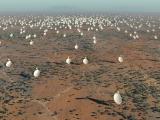
|
04/11/2013
Diez centros de investigación y once empresas españolas participarán en el diseño de SKA, el mayor radiotelescopio del mundo Hoy ha tenido lugar el anuncio de los equipos responsables del diseño definitivo del Square Kilometre Array (SKA), el telescopio mayor y más sensible del mundo. Diez centros de investigación y once empresas de tecnología españolas participarán en el diseño definitivo. |

|
31/10/2013 - 13:30
Digital Science: towards the executable paper The science performed in Astronomy is digital science. This fact does not prevent the final outcome of an experiment is still difficult to reproduce. J. E. Ruiz |

|
30/10/2013 - 10:30
Characterisation of an Isolated Galaxy Sample: Astrophysical Implications In order to understand the evolution of galaxies, it is necessary to have a reference sample where the effects of the environment are minimised and quantified. Recent advances in large redshift galaxy surveys, such as the Sloan Digital Sky Survey (SDSS), allow to reach a 3-dimensional picture of the environment. In the first two parts of this talk, I will present a revision of the isolation degree and a study of the 3-dimensional... Mamen Argudo Fernández Sala de Juntas del Nuevo Edificio (IAA-CSIC) |

|
24/10/2013 - 14:30
AGN feedback and accretion in Perseus A The Perseus Cluster is known as a famous observational example of (radio-mode) AGN feedback driven by the radio jet of the central galaxy Perseus A (NGC 1275, 3C 84). The feedback process is evident from observations of the intra-cluster medium showing X-ray bubbles filled with radio plasma. The radio jet generating these bubbles is powered by accretion onto the supermassive black hole in Perseus A. In this talk, I will present our results... Dr. Julia Scharwächter |
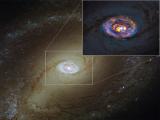
|
24/10/2013
¿Afecta la dieta de un agujero negro supermasivo a su galaxia anfitriona? El telescopio ALMA ha permitido observar en detalle NGC 1433, que presenta un complejo sistema de anillos, barras y espirales que guían el gas hacia el agujero negro supermasivo central |

|
17/10/2013 - 14:30
The Martian ionosphere The ionospheres of the planets (those regions with a significant fraction of free electrons and ions) provide interesting clues about the interaction of the solar radiation and the solar energetic particles with the planetary atmospheres.They can also be used to gain information about the density and temperature of the neutral upper atmospheres, a region that in the Martian case has traditionally eluded observation. In this talk I will sketch... Dr. Francisco González Galindo |
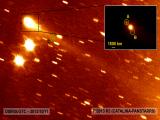
|
17/10/2013
Se observa por primera vez la fragmentación de un cometa del cinturón principal P/2013 R3 (CATALINA/PANSTARRS) está clasificado como "cometa del cinturón principal", un inusual tipo de asteroide que muestra rasgos similares a los de los cometas |

|
10/10/2013 - 14:30
Hot potatoes: the compact obscured nuclei of dusty IR galaxies Evidence is now mounting that most of the activity in some luminous infrared galaxies takes place in their compact obscured nuclei (CONs), regions of less than 100~pc in diameter, which harbor large amounts of warm (T$>$100~K) molecular material (N(H$_2$)$>10^{24}$~cm$^{-2}$). The combined effect of warm, shielded gas and intense infrared radiation produce rich molecular spectra, which make these objects unique laboratories to study... Dr. Francesco Costagliola |
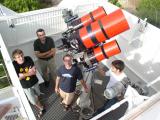
|
09/10/2013
Telescopios que lo hacen todo Los telescopios robóticos permiten estudiar, sin apenas intervención humana, desde objetos en nuestro Sistema Solar hasta núcleos galácticos, pasando por fenómenos transitorios como las explosiones de rayos gamma |

|
07/10/2013 - 11/10/2013
Third Workshop on Robotic Autonomous Observatories Málaga |

|
03/10/2013 - 14:30
Spectroscopy of the short GRB 130603B: The host galaxy and environment of a compact object merger The nature of short duration gamma-ray bursts (GRBs) remains a central problem of modern astrophysics. They are thought to be related to the violent merger of compact objects, such as neutron stars or black holes, which would make them promising sources of gravitational waves. The absence of supernovae signatures clearly indicates that SGRB progenitors differ from their long duration cousins, but constraints to-date arise almost entirely from... Dr. Antonio de Ugarte Postigo |

|
26/09/2013 - 14:30
Main-Belt Comets Since the discovery of 133P/Elst-Pizarro in 1996, an object moving in a typical Main Asteroid Belt orbit, but displaying a comet-like tail, nine more of those objects have been identified. They constitute a new class of small Solar System bodies, the ``missing link'' between asteroids and comets. Three of those objects fall into the ``disrupted asteroids'' subgroup, where the activity is suspected to be driven by either a... Dr. Fernando Moreno |
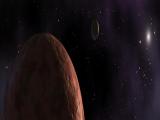
|
26/09/2013
El IAA abre sus puertas con motivo de la Noche de los Investigadores Este viernes 27 el Instituto de Astrofísica de Andalucía abre sus puertas con motivo de la Noche de los Investigadores, jornada en la que los asistentes podrán conocer el universo de la mano de quienes lo estudian |

|
23/09/2013 - 27/09/2013
Galaxies meet GRBs at Cabo de Gata Granada |

|
12/09/2013 - 14:30
Cosmological Simulations of Galaxy Formation We present a suite of simulated galaxies, that match a wide range of scaling relations over a large mass range at z=0, and follow the evolution of these relations and confront them with observational constraints. We then make connections to "galactic archaeology" by examining the nature of the major structural components of the discs, highlighting that far and near field cosmology can be combined using these types of simulations. We... Dr. Chris Brook |

|
05/09/2013 - 14:30
SN 1993J and M81: a fruitful astrophysical collaboration SN1993J, a powerful radio supernova high in the northern sky, has been monitored with VLBI though its lifetime. The VLBI observations have been phase-referenced to the core of M81. We will highlight the main results obtained: its extremely circular shell-like radio structure has expanded over 15 years in a rather self-similar way; the expansion is wavelength dependent, a result which can be mainly explained by a combination of a varying free-... Prof. A. Alberdi |

|
18/07/2013 - 14:30
Can we solve by solar magneto-seismology one of astrophysics great problems: Coronal heating enigma? The latest satellite and ground-based observations have provided us a wealth of evidence of waves and oscillations present in the solar atmosphere from the low photosphere to the upper corona. Our understanding of the magnetically dominated structures and their dynamics in the solar atmosphere has been considerably enhanced in light of the latest high spatial and temporal resolution observations (e.g. DST/ROSA, IBIS, CoMP, SST/CRISP; SOHO,... Prof. Robertus von Fay-Siebenberg |

|
15/07/2013
Granada acoge una prestigiosa cita científica internacional sobre los plasmas de baja temperatura El congreso ICPIG (International Conference on Phenomena in Ionized Gases) reúne a más de quinientos investigadores esta semana en Granada |

|
14/07/2013 - 19/07/2013
ICPIG - 2013: International Conference on Phenomena in Ionized Gases Granada |
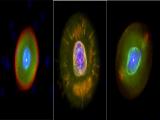
|
12/07/2013
¿Es la estrella central de la Nebulosa del Esquimal un sistema binario? Un estudio ha revelado anomalías en la Nebulosa del Esquimal que apuntan a que su estrella central pudiera ser doble El trabajo aporta evidencias robustas sobre la existencia de una capa de conducción que transfiere energía térmica en las nebulosas planetarias |

|
04/07/2013 - 14:30
The ALHAMBRA survey: First Data Release. The ALHAMBRA (Advance Large Homogeneous Area Medium Band Redshift Astronomical; Moles et al. 2008) survey has observed 8 different regions of the sky, including sections of the COSMOS, DEEP2, ELAIS, GOODS-N, SDSS and Groth fields using a new photometric system with 20 contiguous, ~300A width, filters covering the optical range, plus deep JHKs imaging. The observations, carried out with the Calar Alto 3.5m telescope using the wide field... Alberto Molino |
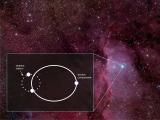
|
04/07/2013
Observada la tercera estrella del sistema HD 150136: un paso adelante en el estudio de las estrellas de masa extrema Las estrellas masivas tienen, a pesar de su escasez, una enorme influencia en la estructura y evolución química de las galaxias |

|
27/06/2013 - 19:00
La muerte del Sol El Sol es nuestra estrella más cercana, la que nos calienta y da vida. Pero aunque hoy es una estrella joven, tendrá que 'morir' como cualquier otra en algunos milles de millones de años. En esta charla hablaremos de cómo van cambiando las propiedades del Sol así como cuál será su futuro. Jesús Toalá |

|
27/06/2013 - 14:30
CALIFA tbd Dr. Sebastián Sánchez |
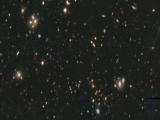
|
24/06/2013
Se publica el "oro" de ALHAMBRA, el catálogo definitivo para el estudio de la evolución del universo Las características de ALHAMBRA, que estudia en detalle ocho regiones profundas del universo y separadas entre sí, lo convierten en la mejor herramienta disponible para conocer la historia reciente del universo. |

|
20/06/2013 - 14:30
El Universo de Planck Recientemente se han presentado los resultados cosmológicos de la misión espacial Planck. Es un buen momento para poner al día el valor de los parámetros del Universo. La nueva composición se resume en 26.8% materia oscura, 4.9% materia visible, 68.3% energía oscura. El valor de la constante de Hubble ha resultado también muy inferior a lo esperado: 67.5 km/(s Mpc). La conclusión m... Prof. E. Battaner |

|
13/06/2013 - 14:30
Love for Science or 'Academic Prostitution'? Note: This is a seminar given at the European Research Council Headquarter some weeks ago. It was focused on the expected audience, members of the ERC directly involved in setting the rules for Grants evaluation and/or participate in all steps of the process, mainly Scientific Officers, but also Agency staff. I have decided to present the talk as it was presented there. Abstract: In a recent Special issue of Nature concerning Science... Dr. Lourdes Verdes-Montenegro |
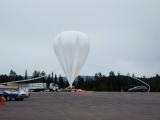
|
12/06/2013
El telescopio solar SUNRISE vuelve a surcar el Ártico en globo SUNRISE, un telescopio solar que viaja en globo estratosférico para estudiar el campo magnético del Sol, se ha lanzado hoy desde el Centro Espacial Esrange, cerca de la ciudad de Kiruna (Suecia) |

|
10/06/2013 - 14/06/2013
Jets 2013: The Innermost Regions of Relativistic Jets and Their Magnetic Fields Granada |
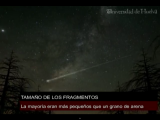
|
07/06/2013
Dracónidas 2011: una tonelada de fragmentos de un cometa impactó contra la Tierra a 83.000 kilómetros por hora Entre el 8 y el 9 de octubre de 2011 la Tierra cruzó la estela de gas y polvo del cometa 21P/Giacobini-Zinner, dando lugar a la intensa lluvia de estrellas fugaces de las Dracónidas |

|
06/06/2013 - 14:30
PAH's in Titan's Upper Atmosphere Observations of Titan's atmosphere made with the VIMS instrument on board the Cassini satellite show a strong limb emission around 3.3 µm at high atmospheric altitudes (above 700 km). This emission exhibits the typical spectral signatures of the strong CH4 bands. A detailed analysis of the spectra reveals, however, an additional strong emission centered at 3.28 µm and peaking at about 950 km. We have untangled this spectral... Prof. Manuel López-Puertas |
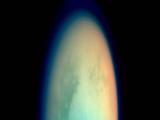
|
05/06/2013
Identifican los compuestos que forman la neblina que cubre Titán, responsable de la estabilidad de su atmósfera Astrónomos del IAA han analizado la señal de un compuesto detectado en la atmósfera de Titán y desvelan la existencia de grandes cantidades de hidrocarburos aromáticos policíclicos. Estos compuestos constituyen la neblina que recubre el satélite, calienta la atmósfera y evita que se condense |
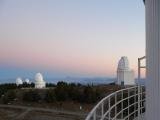
|
05/06/2013
Desacuerdo del personal del Instituto de Astrofísica de Andalucía ante el drástico recorte para el Observatorio de Calar Alto (CAHA) El observatorio, cogestionado por el Consejo Superior de Investigaciones Científicas (CSIC) y por la Sociedad Max Planck (MPG), afronta un recorte presupuestario del 67% con respecto al convenio original 2004-2013 |

|
26/05/2013 - 15:00
Estudio multi-frecuencia de las historias de formación estelar espacialmente resueltas de galaxias en el cartografiado de campo integral CALIFA. ¿Por que estudiar las poblaciones estelares? Los diferentes procesos evolutivos dejan un registro fósil diferente en las propiedades de población estelar de las galaxias. Un metodo muy potente que permite estudiar la formación y evolución de las galaxias consiste en reconstruir la historia de formación estelar a través de las propiedades de las estrellas que las forman. Actualmente se utiliza la técnica de síntesis evolutiva para inferir las... Rafael López Fernández Otra |

|
23/05/2013 - 14:30
Extreme emission-line galaxies: New light on the mass assembly and chemical enrichment of low-mass galaxies Galaxies showing early and significant stages of mass assembling are key objects for understanding galaxy evolution. However, young starbursts like these are extremely rare in the local Universe. In this context, a unique population of compact, low-mass galaxies forming stars at unusually high rates - also known as the "green peas" - emerge now as ideal laboratories to study the details of massive star formation, feedback and... Dr. R. Amorin |

|
23/05/2013 - 00:00
Ciencia en la Antigua China Los registros de las actividades y tradiciones científicas y tecnológicas de China son un claro ejemplo de los más completos, continuos y cronológicamente precisos. Vamos a hacer un viaje por algunas de estas tradiciones, sus etapas iniciales y primeros desarrollos. Descubriremos quiénes eran los científicos de la antigua China, cuál era su motivación y qué encontraron en su camino de exploración de la naturaleza. Rubén García Benito |

|
16/05/2013 - 14:30
Hall motions and star escape in galactic dynamics in the Hill approach The motion of a galactic cluster is approximately described by those equations in a co-moving frame, introduced by Hill in the XIXth century. Individual motions can only studied numerically, but for the center of mass interstellar gravitational forces drop out and one is left with a simply system analogous to those considered by Hall for a planar electron in crossed electric and magnetic fields. In both cases, the motion of the COM is... Dr. P. Horvathy |

|
09/05/2013 - 14:30
The IAA COsmic DUst LABoratory, a lab next door (building). MAIN GOALS of this talk: 1. Let you know/remind you that the IAA has a worldwide reference light scattering laboratory for experimentally studying the angular dependence of the scattering matrices of dust samples of astrophysical interest. 2. Convince the audience of: - Polarization is highly valuable tool for retrieving information on the physical properties of small cosmic dust particles. - How useful laboratory measurements... Dr. O. Muñoz |

|
25/04/2013 - 19:00
El Origen de la Vida sobre el planeta Tierra Una revisión histórica de cómo ha evolucionado nuestro conocimiento y teorías sobre el origen de la vida en el planeta Tierra. Ignacio Núñez de Castro |

|
25/04/2013 - 14:30
X-raying born-again planetary nebulae Planetary nebulae have been a addition to the zoo of X-ray-emitting sources. Here I present results on a the very particular class of born-again planetary nebulae, those whose central star has experienced a helium shell flash during the lifetime of the planetary nebula. The interaction of the fast stellar wind of the central star with hydrogen-poor material ejected during the born-again episode provides a unique case to study... Dr. M. Guerrero |

|
22/04/2013 - 26/04/2013
HOPS Spring Meeting Granada |